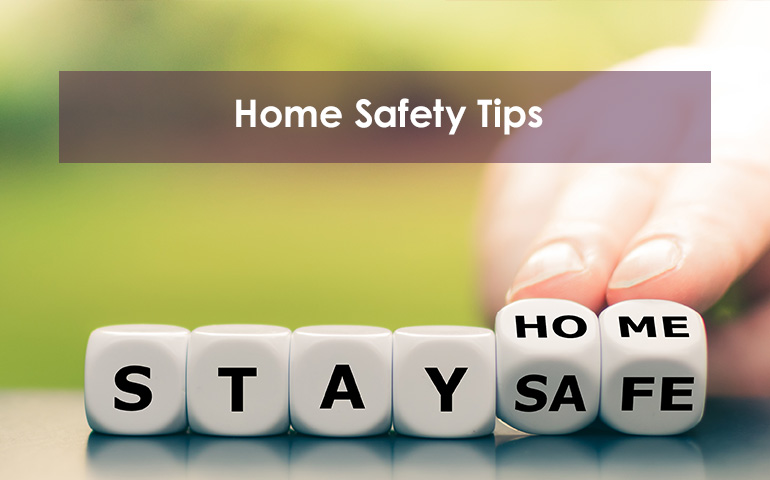
Home Safety Tips
Introduction by Chris Petry & Featured Article by Nancy Mitchell
Happy New Year! Is it still permissible to say that? I mean, we’re only three days in, right? What’s the cutoff? I suppose it’s best not to overthink such things. Especially as this is, in fact, the first blog of 2024. Moving on! One thing we plan to do periodically this year is to highlight the voices of outside contributors, adding much-needed expertise on various real estate-related topics.
To kick things off, we’re starting with this very informative piece on home safety from Nancy Mitchell, an RN and Contributing Writer for AssistedLivingCenter.com. Nancy has over 37 years of experience in geriatric nursing care. Her article Home Safety Tips: Everything You Should Know and A Little More, is a comprehensive look at some of the most overlooked home safety precautions that everyone should be giving more attention. To paraphrase the first line of her piece, home safety goes beyond an alarm system.
We think you’ll really enjoy the tips and information that Nancy has provided on the subject of home safety. Read on below for the full article.
Home Safety Tips: Everything You Should Know and A Little More
by Nancy Mitchell
Contrary to common belief, home safety goes beyond alarms. Installing accessible fixtures,
repairing structural damages, and storing dangerous items are just as crucial as preventing
burglaries. Prioritizing one over the other compromises your overall safety.
But with the work that goes into home safety renovations, we understand if you feel a bit
overwhelmed. You might not even know how to start. To speed up the process, follow these tips
on building a safer, more accessible living space.
1. Anchor Heavy Furniture to The Walls or Floor
Anchor heavy furniture to your walls and flooring for stability. The extra support prevents them
from falling in case someone bumps into them, their foundation falls apart, or an earthquake
hits. Don’t take furniture tip-over accidents lightly. Fixtures weighing several hundreds of pounds could cause serious, possibly even life-threatening, injuries if they fall.
Anchor the heaviest, most unstable pieces in your home first. Bookshelves, cabinets, shoe
racks, and bunk beds need additional support should their main structure break. Afterward, you
can work on smaller yet potentially dangerous furniture.
2. Use Smart Locks Strategically
Carefully choose the smart locks you install. Although there are dozens of affordable DIY
options online, many are vulnerable to brute-force attacks. Skilled hackers can easily override
mediocre systems. We suggest investing in modern smart locks backed by sophisticated
firmware—a few hundred bucks is a small price for your family’s safety.
Also, always keep your paired smartphone secure. Losing it can lead to a home invasion if it
falls into the wrong hands, especially if the thief knows your home address already.
3. Reinforce Your Windows And Doors
Reinforce all the entry points to your living space, including your windows and doors. Don’t just
rely on locks. Apart from deterring burglars, reinforced windows will keep you safe from debris,harsh rains, and strong winds during storms. Aesthetic yet unbarred windows will quickly fly open in bad weather conditions.
Get modifications that will stop your windows and doors from breaking. For instance, you could
strengthen your windows with steel bars, glass-break sensors, shatter-resistant glass, and
sturdy sills. As for the doors, install a thicker frame, attach a kick-down stopper, and replace old
screws with brand-new ones.
4. Integrate Accessible Tools for PWDs And Seniors
Remember that people with disabilities and seniors have different needs from non-disabled
individuals. Let’s say you live with a mobility-impaired older adult. While you can climb up the
stairs, take showers, and use the toilet vacuously, they might struggle with doing these tasks
unassisted.
Create an accessible living space to help them maintain their independence and quality of life.Install fixtures they can rely on to get around the house. Non-slip mats prevent falls, rails make it easier to climb stairs, and specialized mattresses promote better sleep quality.
5. Replace Defective Smoke Detectors
Homeowners tend to delay replacing damaged smoke detectors. Some aren’t aware of the
common warning signs and defects, while others don’t feel the urgency of routine maintenance.
Please note that smoke detectors can spell the difference between life and death during house
fires. Prompt warnings will let you call for help faster.
Anthony Martin, the founder and CEO of Choice Mutual, warns homeowners about taking fire
prevention more seriously. He says, “House fires happen more often than people think. The
NSC reports that over 1.5 million fires broke out in the U.S. in 2022, causing 3,700+ deaths and
13,200+ injuries collectively. Replacing old smoke detectors is the bare minimum of fire
prevention.”
6. Routinely Inspect for Structural Damages
Repairs should always be at the top of any home maintenance checklist. Structural damages
aren’t just an eyesore; they also compromise the overall integrity of your residential property.
Take foundation damage as an example. You might dismiss seemingly harmless hairline cracks,
but these could quickly cause tilted walls if left unattended.
Ryan Zomorodi, the co-founder and COO of RealEstateSkills.com, advises homeowners to hire contractors instead of taking a DIY approach. He says, “Avoid doing major repairs unless you have professional experience. A DIY approach might save you a few bucks upfront, but shoddy craftsmanship puts you and your family at risk of various accidents. Instead, work with
contractors who can help you create a safe living space.”
7. Secure Your Valuables
Installing a home security system doesn’t mean you can place your valuables anywhere. You
should still store them in a safe location. Create a hidden drawer in a designated room that only
you can access—avoid letting guests, relatives, and helpers into this area. They might not have
bad intentions, of course. However, having multiple people walk past your secret safe will make
it harder to rule out suspects in case of theft.
Create A Safe, Secure Living Space. Don’t feel pressured to do all these tips at once. Only use them as a starting point so that you’ll know which areas of your living space to work on first. Remember: your strategy will depend on your needs. If your house has multiple structural damages, work on repairs first. Meanwhile, those living with mobility-impaired individuals could focus on creating a safer, more accessible environment.
Also, take this chance to reconsider your location. You should live in a community that matches
your and your family’s lifestyle.
We suggest working with a trusted real estate company like Berkshire Hathaway Home
Services The Preferred Realty to ensure you get the best deals on the market. It even has a
real estate matching portal that shows relevant listings.





